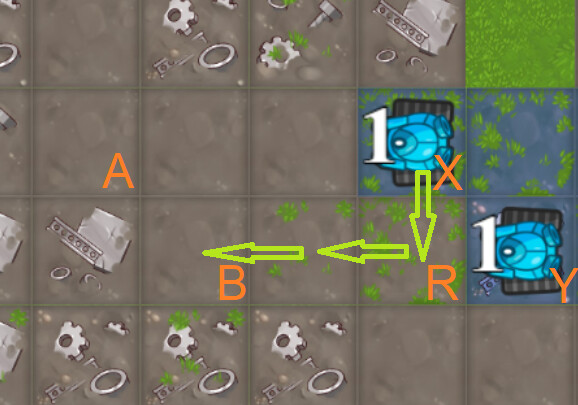Legend 4th.
I used hill climbing. Two players alternatively improve their moves.
I refered this reCurse’s post. It seems that in A Code of Ice and Fire, it was better to take the minimum for all opponent actions, but in this game it was better to take average. I assume this is because this game is simultaneous.
[Possible Actions]
Move: Move to 4 directions or stop for all robots.
Spawn: Only at the edge of my area.
Build: All buildable cells.
[Neighborhood]
・Change direction of movement of one robot
・Add, delete, or change the location of a spawn
・Add, delete, or change the location of a build
Spawn and Build are more likely to be chosen near the opponent’s area.
[Evaluation Function]
First, let me explain what I call the middle cells, which is an important concept. This is the cells where I just collide when my conduct a BFS from my own area and the opponent’s area at the same time. If these are cells, the middle points are that cells; if these are edges, the middle points are the neighboring opponent’s cell.
My evaluation value is a linear combination of four values. In the following, written as “symmetrical” is calculated as the player’s evaluation value minus opponent’s evaluation value.
- Area size I can reach before the opponent (maximized, symmetrical)
This is calculated by BFS as described in the middle points section.
This value determines the movement of my front line units and how to set up recyclers for defense.
- The amount of matter after N turns (maximized, symmetrical)
This determines how the recyclers are placed to earn matters.
At the beginning of the game, N=7 and gradually reduced to N=5 as the game progresses. N=10 was not so good because it destroyed too much of my own cells.
There is a trade-off between the evaluation values 1 and 2. Placing a recycler in my own area decreases the evaluation value 1, but increases the evaluation value 2. This relationship is roughly between 1 cell = 6 matter ~ 16 matter. The larger the map, the higher the evaluation value of matter, and the further the battle progresses, the lower the value of matter.
- The number of cells I lost this turn + the number of opponent cells (minimized)
This is not symmetrical. The reason is that if I simply try to increase the number of my cells, my robots will spread out to neutral cells. This evaluation value affect on the attack and defense of the front line.
- Distance to the middle points of each of my unit (minimized, symmetrical)
Rear units are not yet evaluated in the evaluation values of 1, 2 and 3.
(The evaluation value 1 only affects units in the front line)
Since I want the rear units move to the middle points, I can think of the “middle points” and “my units” as a bipartite graph and perform matching to minimize the total distance, while the remaining units are evaluated based on the distance to the nearest middle point.
However, it is better to match not all the middle points, but only about half of them in order of their distance smaller to my units (I will explain why below).
[Two type Attack strategies]
One of the interesting points of this game is that the strategy was divided into whether to first put multiple units together in the shortest path or to spread them out. The advantage of grouping units in one place is that it is easier to capture the squares at the point where you hit them, while the advantage of spreading out is that it is easier to attack from the edge of the map.
If I match all the middle points to my units, it is a very stretched out formation that is good for attacking from the edge of the map, but is bad for capturing center of the map.
The other way, if I match none of the middle points to my units, it will get a very compact formation that is good for capturing center cells, but is bad for attacking from the edge of the map.
I think the mixed strategy is better than either strategy. Matching only half of middle points, and rest units move to nearest middle point.
[Hashing for distance calculation]
I used ZobristHashing to calculate distances.
Specifically, if the recycler placement is the same, all distances on the map are the same, so we can calculate the recycler placement as a hash value.

